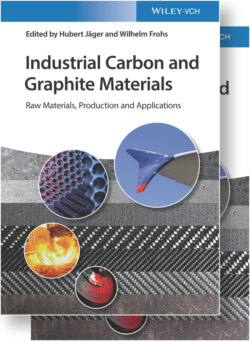Читать книгу Industrial Carbon and Graphite Materials - Группа авторов - Страница 287
6.1.2.4.2 Calcined Petroleum Coke 6.1.2.4.2.1 Anode‐Grade Coke (Regular Calcinate)
ОглавлениеMost calcined petroleum coke is used for production of carbon and Söderberg anodes (Table 6.1.2.5 and Figure 6.1.2.10). Moreover, as aluminum production with Söderberg anodes is declining due to environmental aspects, the requirement will shift more and more to carbon anodes. The coke quality required is called anode‐grade coke or regular calcinate [27].
Worldwide aluminum production was 22.6 × 106 t in 2004 with a growth up to 52 × 106 t/a in 2014. 22.5 × 106 t/a (43%) of the aluminum production capacities in 2014 are located in China. The dominant role held by North America and Western Europe is a thing of the past. 3–5 × 106 t/a aluminum production is nominated from North America, Western Europe, East Europe, Latin America, Asia, and Middle East. Aluminum production is expected to increase about 9% per year. With an average consumption of about 43 kg regular calcinate per ton of produced aluminum, the worldwide regular calcinate demand in the aluminum industry is approximately 21.5 × 106 t/a in 2013. This is 74% of the yearly production of calcined petroleum coke.
The recycling rate for aluminum has increased to about 30% [31, 32]. Therefore, the world aluminum consumption is about 70 × 106 t/a.
The green coke qualities containing relatively low levels of metals like vanadium (typically <200 ppm) and low to moderate levels of sulfur (0.5–2%) are not available in the required amount to make anode‐grade coke. The cause of this is that refineries operate with high sulfur and high metal crudes due to attractive price differential and the demand of anode‐grade coke has increased. Therefore the smelters are increasingly having to adapt to higher sulfur and metal levels [33].
Recent test by companies with “inert” anodes (reduction without carbon) has not been successful due to process economics and aluminum purity [31].
Regular calcinate in the fraction of 0.2–1.0 mm is used for titanium dioxide production. More than 70% of the worldwide TiO2 production is produced using the chloride process. This process needs only about a third compared with the process that is using rutile as reduction medium.
1.2 × 106 t/a regular calcinate is used for titanium dioxide production. The separation of this fraction improves the regular calcinate quality for anodes as the smaller sized material is removed. Otherwise this fraction has a better price than anode qualities.
3–4% of calcined petroleum coke, which is called needle coke, is used to produce graphite electrodes.
The use of calcined petroleum coke as recarburizer in the steel industry is about 2%.
The rest of the calcined petroleum coke is the basic for other specialty markets (2–7%).
